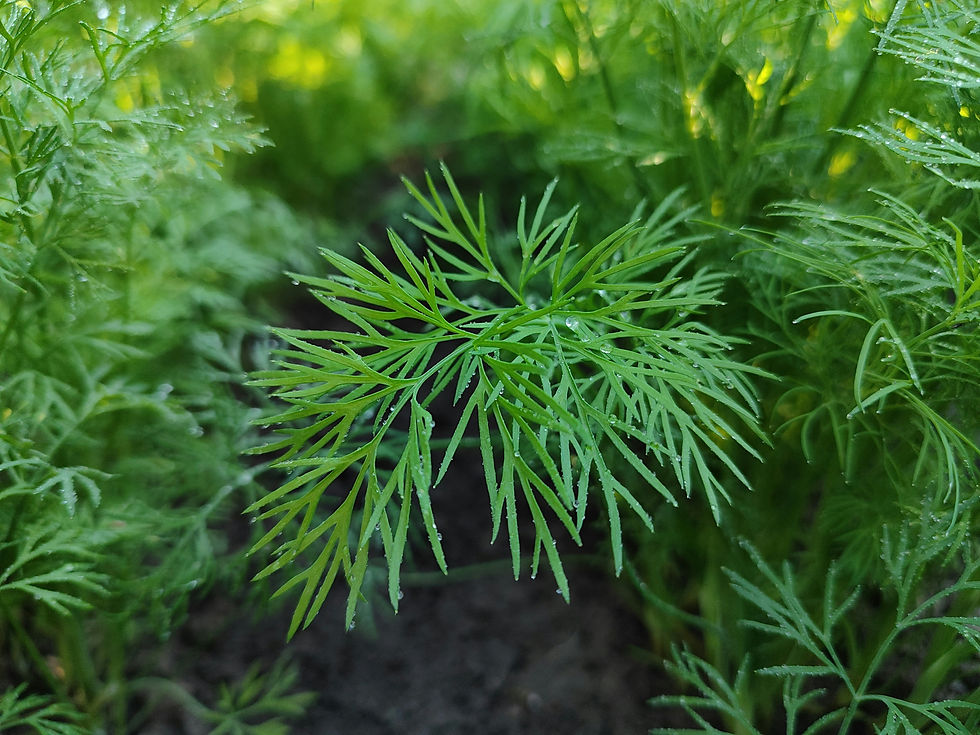Growing Carrots. How to cultivate this Superfood From Your Backyard
- Ange Bose

- Mar 13, 2024
- 6 min read
Updated: May 13, 2024
"Growing Carrots" involves activities such as preparing the soil, planting carrot seeds or seedlings, providing adequate water and sunlight, controlling pests and diseases, and eventually harvesting the mature carrots when they reach the desired size.
If you appreciate the crisp, crunchy texture of carrots, you'll love the fresh taste of homegrown ones. Carrots cultivated in your own garden not only boast exceptional flavor but also acquire extra sweetness when exposed to frost.
Furthermore, they can be stored for several weeks after harvesting, either in a refrigerator or a cool root cellar. Abundant in vitamins, low in calories, and rich in fiber, carrots serve as a nutritious snack and complement juices and baked goods splendidly, imparting moisture to cakes and muffins. Additionally, harvesting each carrot feels akin to unearthing a treasure from the soil.
Guide to Growing Carrots
Soil Preparation
Choose a well-draining, loose soil free from rocks and clumps. Amend heavy or clay soils with compost to improve drainage and texture.
Seed Planting
Plant carrot seeds directly into the garden bed or container about 1/4 to 1/2 inch deep. Space the seeds 2-3 inches apart in rows spaced 12-18 inches apart.
Watering
Keep the soil consistently moist but not waterlogged. Water deeply once or twice a week, especially during dry spells. Avoid overhead watering to prevent foliage diseases.
Thinning
Once the carrot seedlings emerge, thin them to 2-3 inches apart to allow room for proper root development. Use scissors to snip off the excess seedlings at ground level rather than pulling them, which can disturb the remaining plants.
Weeding
Keep the carrot bed weed-free to prevent competition for nutrients and water. Use a shallow hoe or hand-weeding to remove weeds, taking care not to damage the carrot roots.
Mulching
Apply a layer of organic mulch, such as straw or shredded leaves, around the carrot plants to conserve moisture, suppress weeds, and protect the roots from temperature fluctuations.
Fertilizing
Carrots don't require heavy fertilization, but you can apply a balanced fertilizer low in nitrogen once or twice during the growing season to promote healthy root development.
Harvesting
Carrots are usually ready for harvest 60-80 days after planting, depending on the variety. Harvest when the carrots reach the desired size and color, gently loosening the soil around the roots and pulling them up. Be careful not to damage the roots.
Storage
After harvesting, remove the tops and brush off excess soil. Store carrots in a cool, humid environment, such as a refrigerator or root cellar, where they can last for several weeks.
By following these steps, you can successfully grow your own carrots and enjoy a bountiful harvest of fresh, nutritious vegetables.
Soil, Planting, and Maintenance
Carrots encompass a comprehensive set of practices and considerations essential for nurturing robust and productive carrot plants from seed to harvest. This multifaceted process begins with soil preparation, where the selection of an appropriate planting site and soil type plays a crucial role.
Carrots thrive in well-draining, loose soil that is free from rocks and clumps, with a slightly acidic to neutral pH range of around 6.0 to 7.0. Prior to planting, it's recommended to loosen the soil to a depth of at least 12 inches and incorporate organic matter such as compost or aged manure to improve soil structure, fertility, and moisture retention.
Carrots encompass a comprehensive set of practices and considerations essential for nurturing robust and productive carrot plants from seed to harvest. This multifaceted process begins with soil preparation, where the selection of an appropriate planting site and soil type plays a crucial role.
Carrots thrive in well-draining, loose soil that is free from rocks and clumps, with a slightly acidic to neutral pH range of around 6.0 to 7.0. Prior to planting, it's recommended to loosen the soil to a depth of at least 12 inches and incorporate organic matter such as compost or aged manure to improve soil structure, fertility, and moisture retention.
Once the soil is adequately prepared, the next step involves planting carrot seeds or seedlings at the correct depth and spacing. Carrot seeds should be sown directly into the garden bed or container, ideally in rows spaced 12-18 inches apart, with the seeds planted approximately 1/4 to 1/2 inch deep.
Proper spacing is crucial to allow sufficient room for the carrots to develop and avoid overcrowding, which can result in stunted growth and irregularly shaped roots. As the carrot seedlings emerge, thinning is necessary to remove excess seedlings and maintain adequate spacing, typically to a distance of 2-3 inches apart.
Careful attention to watering and moisture management is essential throughout the growing season to ensure optimal growth and development of carrot plants. Carrots require consistent moisture to prevent the soil from drying out, but it's equally important to avoid overwatering, as waterlogged conditions can lead to rot and disease. Deep, infrequent watering is recommended, allowing the soil to dry out slightly between waterings.
Mulching the soil surface with organic materials such as straw or shredded leaves can help conserve moisture, suppress weeds, and regulate soil temperature.
In addition to watering, proper care for carrot plants involves regular maintenance tasks such as fertilizing, weeding, and pest control. While carrots are relatively low-maintenance plants, they can benefit from occasional fertilization with a balanced fertilizer to provide essential nutrients for healthy growth.
Weed control is also important to prevent competition for nutrients and moisture, which can inhibit carrot growth. Hand-weeding or shallow cultivation with a hoe can help keep weeds in check without disturbing the delicate carrot roots.
Finally, monitoring for pests and diseases is essential to protect carrot plants from potential threats. Common pests that may affect carrots include carrot rust flies, aphids, and wireworms, while diseases such as carrot root rot and powdery mildew can also pose challenges. Implementing cultural practices such as crop rotation, proper sanitation, and selecting disease-resistant varieties can help minimize the risk of pest and disease problems.
Overall, soil preparation, planting techniques, and ongoing care are integral components of successful carrot cultivation, ensuring a bountiful harvest of flavorful and nutritious carrots for enjoyment throughout the growing season.
Troubleshooting
Monitor your carrot crop closely, as certain pests find them quite appealing. Aster leafhoppers, resembling 1/8-inch green slivers, are easily noticeable as they hop when disturbed.
Although they cause minimal damage, they can transmit a disease called "aster yellows" that can negatively affect carrots. Carrot rust flies, flea beetles, and carrot weevils are also attracted to carrots. To prevent pests and safeguard your crop, consider using lightweight row covers over your plants.
Excessive nitrogen in the soil can result in hairy or misshapen carrots. Utilizing row cover fabric and Performance Organics soils when preparing your beds can help mitigate this concern. Additionally, be sure to clear any rocks or roots from your garden bed before planting carrots to prevent the formation of unattractive vegetables.
Carrots planted in spring and left in warm summer soil may become fibrous, so it's advisable to harvest them before the soil temperature rises too high. Similarly, for fall-planted carrots, it's best to harvest them before the ground freezes. Alternatively, you can apply a thick layer of straw mulch over the carrots to maintain warmth and facilitate winter harvests.
Harvest and Storage
It may seem tricky to know when to harvest carrots, but as the veggies mature, you'll begin to see the shoulders emerge from the soil. Many carrot varieties take 60 to 80 days to mature when planted from seed, but Baby Carrots should be ready for harvest about 30 to 40 days after planting.
Don't leave spring-planted carrots in warm soil, though it's better to harvest them a little early than too late. Fall-grown carrots that mature in cool soil can be left longer before harvest, but dig them before the ground freezes to preserve their quality.
To harvest carrots, loosen the soil around the root with a trowel, then gently pull the carrot from the ground. Remove the green tops to prevent moisture loss, rinse the roots, pat them dry, then store them in an airtight plastic bag in the refrigerator or cold root cellar for up to 2 months. Carrots can also be pickled, canned, dried, or frozen.
How are carrots propagated?
Carrots are propagated by sowing seeds directly into the soil. The seeds are planted at the appropriate depth and spacing, typically in rows, and germinate within a few weeks under the right conditions. Once the seeds germinate, carrot plants develop a taproot, which grows downward into the soil and eventually forms the edible carrot root. Carrots are primarily grown from seeds, as they do not readily produce offsets or runners like some other plants.
Is carrot propagated by cutting?
No, carrots are not propagated by cutting. They are primarily propagated by sowing seeds directly into the soil. While some plants can be propagated by cuttings, carrots do not produce viable roots from cuttings of their stems or leaves. Therefore, the most common and successful method of propagating carrots is through seed propagation.
Can you eat carrot leaves?
Yes, carrot leaves are edible and can be consumed, but they are not commonly eaten as they have a slightly bitter taste. Carrot leaves are rich in nutrients, including vitamins A and C, as well as calcium and potassium. They can be used in small quantities as a garnish or added to salads for a touch of greenery. However, it's important to note that carrot leaves contain alkaloids, which can be toxic in large quantities. Therefore, it's best to consume carrot leaves in moderation and avoid eating large amounts of them. Additionally, be sure to wash carrot leaves thoroughly before consuming them to remove any dirt or contaminants.











































Comments